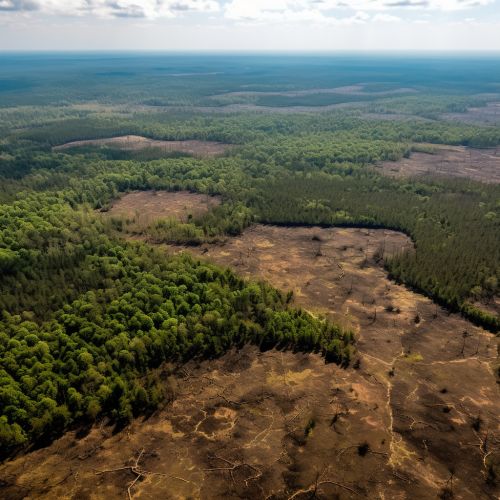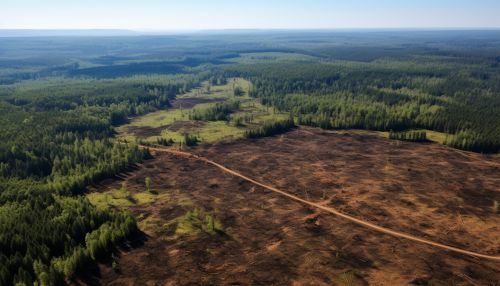Deforestation
Introduction
Deforestation is the process of removing or clearing trees from forests, often to make way for agricultural activities, logging, or urban development. This practice has significant impacts on the environment, including biodiversity loss, climate change, and soil erosion. Deforestation is a global issue, with the highest rates occurring in the tropics, particularly in countries such as Brazil, Indonesia, and the Democratic Republic of Congo.


Causes of Deforestation
Deforestation is primarily driven by human activities. The main causes include:
Agriculture
Agriculture is the leading cause of deforestation. Farmers clear forests to create space for planting crops or rearing livestock. This is particularly prevalent in developing countries where agriculture forms a significant part of the economy. Industrial agriculture, which involves the cultivation of cash crops such as soy, palm oil, and cocoa, also contributes significantly to deforestation.
Logging
Logging is another major cause of deforestation. Trees are cut down for timber or to make products such as paper. Illegal logging, where trees are felled without permission, is a significant problem in many countries and contributes to the loss of forests.
Urbanization
As populations grow, more land is needed for housing, infrastructure, and industry. This often leads to the clearing of forests, particularly in rapidly developing countries.
Mining
mining operations often require large areas of land to be cleared. This is particularly the case for open-pit mines, which can have a significant impact on local ecosystems.
Impacts of Deforestation
Deforestation has a wide range of environmental and social impacts.
Biodiversity Loss
Forests are home to a vast array of species, many of which are not found anywhere else. Deforestation can lead to the extinction of these species, a process known as biodiversity loss.
Climate Change
Forests play a crucial role in the global carbon cycle. They absorb carbon dioxide from the atmosphere and store it in their biomass. When forests are cleared, this carbon is released back into the atmosphere, contributing to climate change.
Soil Erosion
Trees help to hold soil in place. When they are removed, the soil can be washed away by rain, leading to soil erosion. This can reduce the fertility of the land and lead to desertification in extreme cases.
Solutions to Deforestation
There are several strategies that can be used to combat deforestation.
Sustainable Forestry
Sustainable forestry involves managing forests in a way that maintains their biodiversity and productivity for future generations. This can involve practices such as selective logging, where only certain trees are cut down, and replanting, where trees are planted to replace those that have been felled.
Protected Areas
Creating protected areas, such as national parks and wildlife reserves, can help to conserve forests. These areas are often legally protected from activities such as logging and agriculture.
Reforestation
Reforestation involves planting trees to restore deforested areas. This can help to rebuild ecosystems and sequester carbon.
